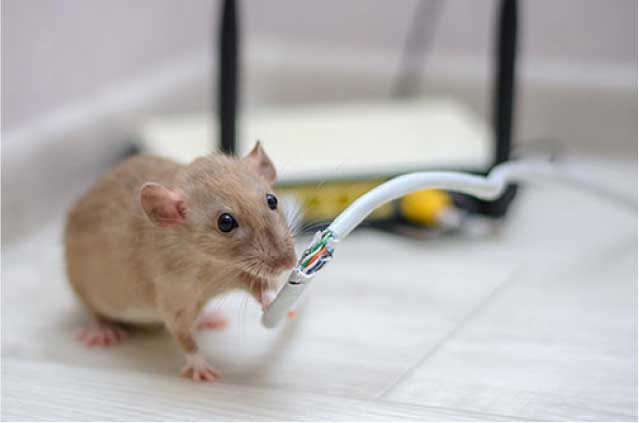
How Rodent-Resistant Are Your Cables? A Cable Test Is the Only Way to Find Out!

Nowadays, many activities rely heavily on electricity and data connections through cables. Any disruption to these cables can become a nightmare, both for individuals and businesses. One often-overlooked cause of such disruptions is attacks by various types of pests.
The damage they cause not only leads to financial losses due to costly repairs but also poses safety risks such as short circuits and even fires. Why do these animals attack cables? What types of pests are the most common culprits? This article will further explore the kinds of pests known to damage cables and how they do it.
- Rodents: The Most Common Cable Chewers
- Insects: Small but Invisible Threats
- Birds: Cable Damagers from the Air
- Other Pests: Unexpected Disruptors
Rodents: The Most Common Cable Chewers
Rats, mice, and squirrels have teeth that continuously grow, so they need to gnaw on hard objects, including cables. Their teeth can chew through the cable insulation, exposing the sensitive inner components. This kind of damage can lead to electrical short circuits, fires, or disruptions in data networks.
Rodents don’t only attack indoor cables; they also damage aerial and underground cables. They often use cable conduits as shelter and travel routes. Squirrels, which are a type of rodent, are among the most common culprits causing damage to outdoor network cables. They frequently jump onto aerial cables and chew on various parts. This type of damage is particularly common in tree-rich environments.
Insects: Small but Invisible Threats
Subterranean termites usually attack cables when their primary food sources are scarce. They dig tunnels and penetrate underground cables, damaging the protective layers and the inner parts. Termite-damaged cables can cause system failures without any clear physical signs on the surface.
The most vulnerable types of cables are those used for electricity or telecommunications that lack adequate protection. Termite attacks often occur in moist environments near the termites’ natural habitats. Because their activity is hidden, the damage is usually only discovered once a disruption occurs.
In addition to termites, ants are also among the insects that threaten cable security. Ants are attracted to cable junction boxes and narrow spaces because they are warm and safe for nesting. They can interfere with connections inside optical cables or damage micro-connectors. Ant colonies can also cause overheating, which damages devices.
Some ant species even bite into small wires inside connectors, disrupting the flow of electricity or data. In some cases, ants have been found to cause short circuits in electrical panels by coming into direct contact with live components. This issue is common in tropical environments with high ant populations.
Birds: Cable Damagers from the Air
As summer approaches, crows typically enter mating season and begin building nests. They look for strong and slender materials like twigs—or even bits of wire—for their nests. In the process, crows sometimes bite into drop cables, which connect support wires to fiber optic lines. Their bites can damage the cable’s inner components, including the fiber optics that are vital for internet or communication links.
Woodpeckers are known for pecking tree trunks with their beaks, either to find insects, attract mates, or mark territory. However, these birds sometimes also peck at telecommunication cables. As a result, the cable's protective layer may be damaged, and the internal components—such as copper wires—can be affected. This can disrupt communication or internet services.
Other Pests: Unexpected Disruptors
Centipedes and silverfish generally do not chew on cables, but they can enter electronic devices and cause disruptions. Their presence increases humidity and can lead to mechanical damage to components. This often occurs in poorly maintained control rooms.
Bees have even been found building hives inside electrical panels or network devices. Their nests can block ventilation, causing overheating. In some cases, this results in equipment failure.
Gophers, a type of burrowing rodent, frequently damage fiber optic cables. They dig and chew on cables undetected because their activities occur underground. Damage is usually only noticed after a network outage.
Gophers can penetrate even the toughest cable sheaths, making them a serious threat to cables buried in large-scale infrastructure projects. Repairing gopher-related damage is costly, often requiring heavy equipment and extensive re-digging.
As a cable manufacturer, ensuring your products are resistant to pests, moisture, and extreme conditions is no longer an option, it's a necessity. IML Research provides custom-designed cable durability testing services to help you demonstrate product quality, safety, and durability before they reach the market. Get accurate, comprehensive, and reliable test results to back up your quality claims. Contact IML Research for testing recommendations that meet established standards.
Author: Dherika
References
Maejima, H. (2014). Countermeasures against cable failures caused by animals and insects. NTT Technical Review, 12(12), 1–5. https://www.ntt-review.jp/archive/ntttechnical.php?contents=ntr201412pf1.pdf&mode=show_pdf.
Miyazaki, T. (2011). Cable failure caused by birds. NTT Technical Review, 9(6), 1–6. https://www.ntt-review.jp/archive/ntttechnical.php?contents=ntr201106pf1.pdf&mode=show_pdf.
